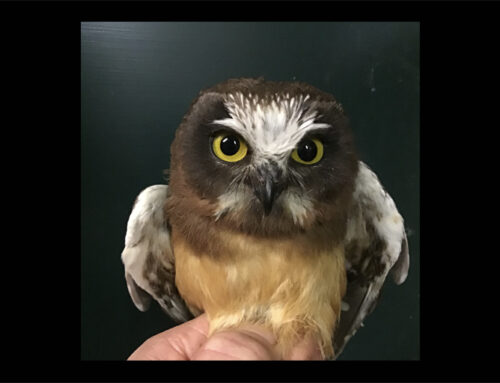The varying weather conditions have naturally been affecting the owl migration, but we’ve had a few good nights since our last post. We continue to be surprised by the low numbers of Northern Saw-whet Owls recently. During the first five nights of the season, nightly numbers of saw-whets hit double digits three times. Despite some nights with excellent weather conditions for migration, saw-whet numbers have not hit double digits since the night of March 23. Boreal Owls have been somewhat sporadic, but that is likely more due to recent weather patterns, as they have remained slow but steady on nights with good weather. The only change since our last post is that Long-eared Owl numbers have begun to pick up. Long-eareds made their first push of the season ahead of the weather system that has brought winter back and shut us down for three nights. We also saw our first Barred Owl of the season and banded the second Great Horned Owl since our last post. To date, we have banded 147 saw-whets, 17 boreals, 57 long-eareds, and two great horneds.
We noticed that a lot of people enjoyed making guesses as to what species the feet belonged to on a recent WPBO Facebook post. We’re going to continue the raptor foot fetish fun by posting the feet of all the species that people guessed on that post. We’re also including Bald Eagle feet, just because their talons are insanely huge. The feet in question belonged to the Great Horned Owl from our last blog post. Many folks nailed it, but the other guesses were; Snowy Owl, Long-eared Owl, Barred Owl, and Rough-legged Hawk. Although we have never banded Snowy Owl, Rough-legged Hawk, or Bald Eagle for WPBO, we have been fortunate enough to work with them on other projects.
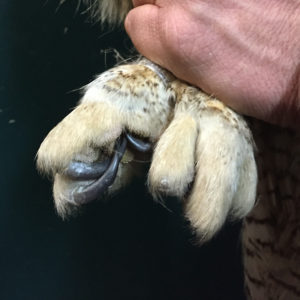
The Great Horned Owl’s feet from the Facebook photo quiz.
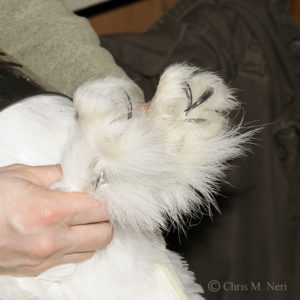
Snowy and Great Horned Owls effectively have the same feet, except the feathering. The snowy’s feet are incredibly feathered to keep them warm in extremely cold conditions.
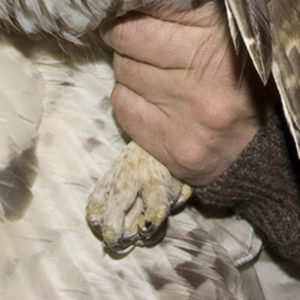
Barred Owl feet.
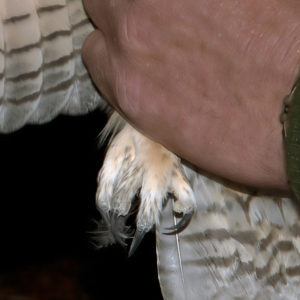
Long-eared Owl feet.
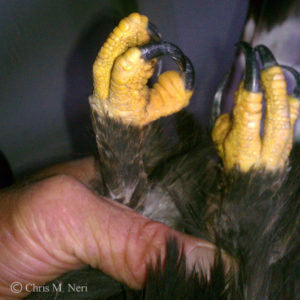
Rough-legged Hawk feet.
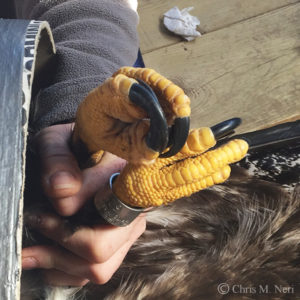
Bald Eagle feet.
It’s amazing how small and unthreatening the Long-eared Owl’s feet look in comparison to the others shown here. They obviously are significantly smaller and incapable of doing the serious damage that some of the others can, but they still really hurt. Not to tempt fate, but long-eareds are the largest raptors that have sunk their talons into my hands. They inflict a lot of pain, and once they really get hold of you, it is ridiculously difficult to get the talons out. During the spring season, the sound of our groans regularly fills the night air back in the net lanes. Thankfully, once we have them back inside for the banding, we rarely mess up enough for them to get us. However, their legs are the perfect size and length for them to get hold of our clothes regularly. We have done a lot of repair to down jackets and had a lot of our shirt sleeve cuffs stretched out thanks to long-eareds. I have often thought about posting an online review of my favorite shirt, “Absolutely love this base layer, but the Long-eared Owls really stretch out the sleeve cuffs.”
Chris Neri & Nova Mackentley
WPBO Spring Owl Banders
If you are considering visiting the Point, please read this important message from Michigan Audubon and WPBO Field Staff.
Maneuvering the ever-changing implications of COVID-19 has necessitated constant adaptation and evaluation for us all. Michigan Audubon and WPBO have been proactive in taking measures that protect our staff, our physical community in Paradise, and the Michigan birding community, and we have found American Birding Association’s recent guidelines on birding and social distancing a useful resource for guiding bird-related travel decisions. While there are hopeful signs that we are rounding the corner with this virus, Michigan Audubon does not want to sow precocious optimism that encourages long-distance travel. Please take a minute to read these ABA guidelines, and to imagine them through the lens of the eastern Upper Peninsula, which does not have the medical resources of Michigan’s more-developed areas. Chippewa County and its adjacent counties have just three hospitals, and only one of these has more than 100 beds; they all are at least an hour’s drive from the Point. WPBO appreciates and requests your continued conscientiousness as the season’s migration begins to ramp up, and does not condone birding travel that is not local. Keep in mind that the Owl’s Roost Gift Shop and public observation of owl banding are currently closed. In the meantime, we will virtually share the Point with you as best we can until it is safe for all parties to enjoy it together. We hope that will be soon.



